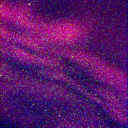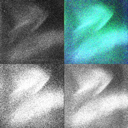ASK (Auroral Structure and Kinetics)
ASK is a collaboration between the Space Environment Physics group in Southampton and the Space Plasma Physics group at KTH in Stockholm, and is jointly funded by NERC/STFC and the Swedish Research Council. ASK consists of three narrow angle (3° FOV) cameras aligned with the local magnetic field, each imaging through a different narrow-band spectral filter. The cameras use electron-multiplying CCDs (EMCCD), a fairly new technology giving an extremely high sensitivity with a low noise level, and are capable of running at very high temporal resolutions typically up to 32 Hz (frames per second). These characteristics provide for detailed studies of the fine structure and morphology of the aurora. ASK also has two photometers, again with different narrow-band spectral filters, to support the main observations made with the cameras.
Some compressed sample videos are available for download, all of which are displayed in the original recording frame rate of 20 fps, and in false colour.

Video 1: Composite video from three wavelengths (nitrogen and oxygen bands) showing highly dynamic structured aurora. (2.43 MB)

Video 2: Simultaneous video sequences from the three cameras (top-left; O2+, bottom-left; OII, bottom-right; O+, top-right; composite image) showing the rapid evolution of auroral structures. The change in colour in the composite video is an indication of the change in energy of the preciptating electrons producing the aurora. (4.10 MB)

Video 3: Spectacular aurora exhibiting especially interesting arc formations with complex energy distributions. (1.16 MB)
ASK was stationed at the EISCAT site in Tromsø during winter 2006/7, and was run jointly with the UHF radar and the ionospheric heater. However it is now located at the EISCAT Svalbard Radar site. For more information about ASK please see the joint Southampton-KTH ASK website.
If you would like access to ASK data, please contact Prof. Betty Lanchester.
ASK Scientific Objectives and Questions
Formation of the fine structure
- Mechanisms leading to the structure formation. Why are auroral arcs thin [Borovsky, 1993]?
- Is it related to dispersive Alfvén waves [Stasiewicz, 2001]?
- Does the structuring take place in the generator region, acceleration region, or further down?
- What is the role of the lower ionosphere?
Plasma drifts in the F-layer
- Imaging of active structured aurora in the forbidden ion line
- This can provide a direct observation of plasma drifts in the topside ionosphere, thus giving electric fields.
- What is the role of proper motion of auroral arcs [Haerendel, 1993]?
Ionospheric effects of the fine auroral structure
- Filamentary structures affect the macroscopic effects of aurora (e.g. efficient electron and ion heating).
- Averaging of nonlinear quantities yields results that depend on the variances [Semeter, 2002].
- Intriguing effects are naturally enhanced ion acoustic echoes in ISR data, related to structured active aurora [Blixt, 2005], [Grydeland, 2004].
Spatio-temporal characteristics of the structuring
- Are statistical distributions of auroral scale sizes related to characteristic energies?
- What do the apparent "optical flow" [Blixt, 2005] and vorticity [Vogt, 1999] tell us?
- Time of flight energy dispersions are common rocket and satellite features in particle data [eg. Andersson, 2002].
- What are their spatial properties?